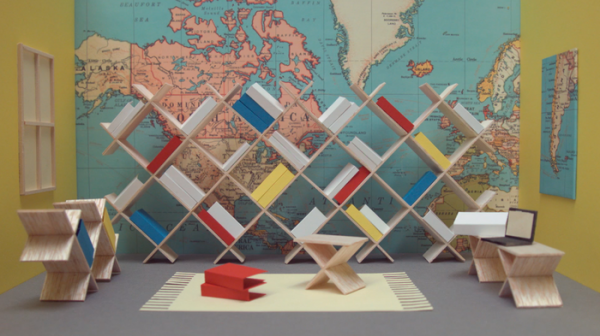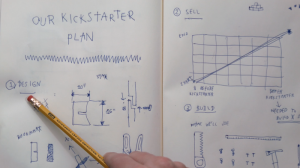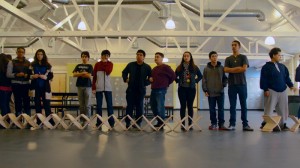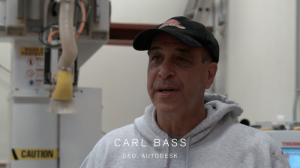Berkeley Eighth Graders Raise Over $78K on Kickstarter, Build a School Library

Student-built prototypes of bookshelves for a new school library. Credit for all photos: Studio H
Eighth-grade students at REALM charter school in the Berkeley Unified School District in Berkeley, CA, have designed their own crowd-funded library, complete with geometric shelving and furniture units built by students and teachers, along with new books and technology purchased with donated funds.
The “X-Space,” as students have named their new library, was the brainchild of students in a REALM class called Studio H, an innovative design program run by Emily Pilloton, the school’s director of creativity. The three-year-old charter school is located in a former commercial space that had no library area. The seeds of the X-Space were planted when Hallie Chen, an eighth-grade instructor, sent a simple survey to about 100 of her students asking, "What is a traditional library? What would you like to learn?"
Students brainstormed a design scheme for the new library at the REALM charter school.
That produced a wish list of what they wanted in terms of design, books, and technology. In addition to WiFi, the students also asked for lots of books, with an emphasis on history. “Most of them know you can’t trust everything on the Internet,” Chen says. REALM's students were hoping to raise $75,000 through a campaign on the crow-funding site Kickstarter. When the month-long drive ended on March 27th, they had $78,843 in donations. On top of that, the Quest Foundation of Danville, CA, a private grant-making organization, had pledged an additional $30,000 if the school reached their project goal. In total, REALM will receive $108,843.
Eighth-grade library builders.
The $75,000 Kickstarter target money covers the costs of “approximately $30,000 for books—3,000 volumes; $20,000 for construction materials, lighting, fixtures, hardware; $15,000 for technology, and $10,000 for software, subscriptions, periodicals and ebooks,” according to a statement on the Kickstarter page. The Quest money and extra Kickstarter funds will allow the purchase of an extra 3,000 books as well as additional shelving and technology. Pilloton and Chen wanted to conceive a design concept that would be affordable and easy for the students to work on collaboratively. The group came up with the idea for a building-block “X” shape that could be used over and over to create bookshelves, table legs, seating, and desks and dubbed their design concept “STAX.”
The student-invented STAX building system uses hundreds of X-shaped units.
As a charter school, REALM has a board of directors but no school board to provide or approve funding for projects. Chen and school administrators decided to turn to Kickstarter because it "the school is like a start-up where innovation and entrepreneurship [are] at the heart of everything," Chen says. In addition to raising funds, Chen and Pilloton sought local support for the X-Space from Carl Bass, CEO of Autodesk, a company that designs software for entertainment, engineering, and construction purposes. Bass has a personal workshop in the school’s neighborhood where he uses computers to cut materials to exact specifications.
Autodesk CEO Carl Bass.
Bass offered to support the X-Space by cutting their building materials—13-ply plywood—to the exact size the students needed for the STAX units. This enabled the eighth-graders to calculate the precise amount of wood they would need to furnish their allotted space. “He and his shop mate put in probably 80 hours of their personal time to help us cut over 900 pieces,” says Pilloton.
Construction tools.
Chen says that Bass’s support was critical to the project’s success. She notes that "If you can demonstrate competence,” tap into local resources, provide a realistic time line, and accurately determine costs, people will see a project as feasible and will be more likely to fund it.The Studio H crew had undertaken a previous Kickstarter campaign to help their school. In that case, high school design students raised $15,000 to buy old shipping containers, which they used to house additional classrooms on the REALM school lot.
While enriching the school, crowd-funding student-driven projects is also a good way “to hack the education system,” says Chen.RELATED
The job outlook in 2030: Librarians will be in demand
The job outlook in 2030: Librarians will be in demand
ALREADY A SUBSCRIBER? LOG IN
We are currently offering this content for free. Sign up now to activate your personal profile, where you can save articles for future viewing






Add Comment :-
Be the first reader to comment.
Comment Policy:
Comment should not be empty !!!